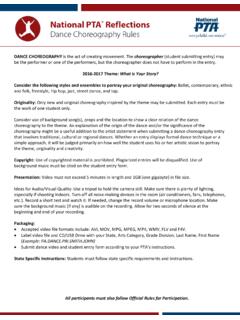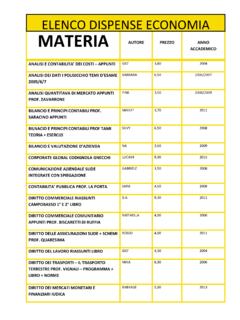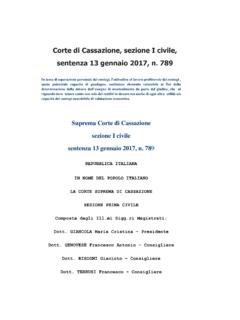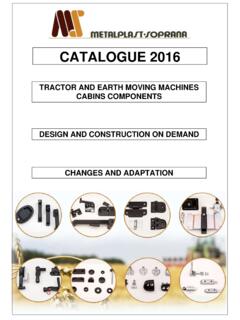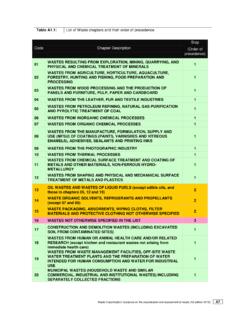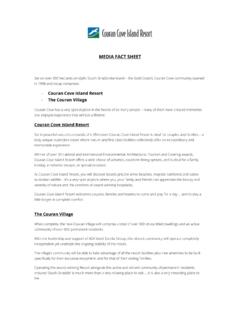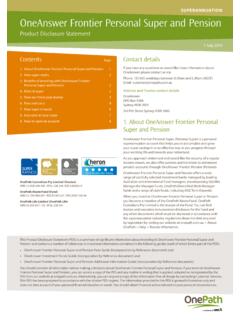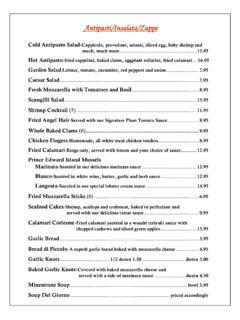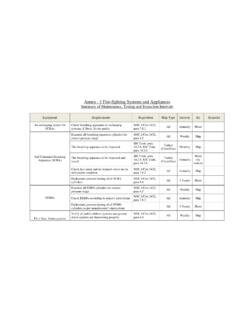Transcription of FIRE SAFETY LOG BOOK - irp-cdn.multiscreensite.com
1 fire SAFETY log book MARCH 2013 fire SAFETY LOG BOOK (Record of fire SAFETY Equipment Testing) fire SAFETY log book MARCH 2013 1 CONTENTS PREMISES SPECIFIC INFORMATION fire SAFETY EQUIPMENT TESTING Escape Routes fire Warning Alarms and fire Detection Systems fire fighting Equipment Emergency Lighting RECORDS OF DRILLS AND TRAINING OTHER ITMES FOR CONSIDERATION SITE SERVICES LOCATION PLANS WHERE APPROPRIATE.
2 fire SAFETY log book MARCH 2013 2 PREMISES SPECIFIC INFORMATION ADDRESS OF THE PREMISES RESPONSIBLE PERSON(S) COMPETENT PERSON(S) NAME AND ADDRESS OF THE OWNER(S) OF THE PREMISES This fire SAFETY logbook and maintenance record should remain on the premises at all times. The register will assist you in proving compliance with your legal responsibilities in relation to fire SAFETY and should be completed following the inspection, test and maintenance of any of the items required by the legislation.
3 The logbook should be available for inspection by any fire Officer who inspects your premises under the Regulatory Reform ( fire SAFETY ) Order 2005. It should also be available to relevant employees or any service engineer as required. Detailed information in relation to the testing and maintenance of specific items can be obtained by referring to the relevant standard and/or the manufacturers instructions. fire SAFETY log book MARCH 2013 3 IMPORTANT: Your legal responsibilities in relation to the fire precautions in your premises are outlined in the relevant HM Government guide to fire SAFETY Risk Assessment available from the Stationary Office or they can be downloaded free at Where Reference is made to British Standards or standards provided by other bodies the reference is intended as guidance only and compliance with any standard is not intended to confer a presumption of conformity with the requirements of the Regulatory Reform ( fire SAFETY ) Order 2005.
4 The level of necessary SAFETY (or service) must be dictated by the findings of your risk assessment, so you may need to do more or less than that specified in any particular standard referred to. You must be prepared to show that what you have done complies with the requirements of the Order irrespective of whether you have relied on any particular standard. fire SAFETY EQUIPMENT TESTING fire SAFETY log book MARCH 2013 4 Escape Routes All escape routes from your premises must be properly maintained and kept free from obstruction at all times.
5 A regular inspection should be carried out to ensure that: a) All doors that are on escape routes must be easily openable without the use of a key or special procedure. b) All escape routes, including staircases, corridors, doorways, etc. are free from obstruction. c) All self-closing devices fitted to doors should be effective in operation. d) All doors fitted with automatic door release mechanisms specified in your risk assessment should be tested in conjunction with tests for the fire warning system (see section 2). e) All walls, doors, floors and glazing, which are required to stop the passage of fire and smoke should be inspected to ensure that the fire and smoke resistance is being maintained no holes in walls and floors, no broken glazing, doors are not damaged and smoke seals touch the door and frame continuously, etc.
6 NOTE: Before making any alteration to the internal layout of the premises, the risk assessment must be reviewed. fire SAFETY EQUIPMENT TESTING fire SAFETY log book MARCH 2013 5 fire Warning (Alarm) and Automatic fire Detection Systems The owner or any other Responsible Person having control of the building should appoint a competent person to carry out any necessary work to maintain the system in correct working order which should including the keeping of records. Such a person should be suitably qualified and have received adequate training from the manufacturer, supplier or installer of the fire alarm system .
7 The following tests/inspections should be carried out in addition to any other tests recommended by the manufacturer, supplier or installer of the system . Please refer to the Maintenance Schedule for recorded servicing frequency. a) Weekly Test The system should be tested at the same time every week using a different call point each time. This ensures sequential testing of all call points . It is recommended that each call point is identified and the identification recorded in this register following the test. b) Periodic Inspection and Test The responsible person should ensure that the time between inspections shall be based on a risk assessment but should not exceed 6 months.
8 A comprehensive check and test sequence should be carried out by a competent person, in accordance with the current standard such as the British Standard for fire detection and fire alarm systems for buildings BS5839 Pt1. c) Electrically Controlled Door Release Mechanisms In premises where electrically controlled door release mechanisms are used and linked into the fire alarm system , they should be tested weekly in conjunction with the fire alarm test to ensure their correct operation on actuation of the alarm. These devices should also be tested by operating the manual release mechanism to ensure it works satisfactorily.
9 fire SAFETY EQUIPMENT TESTING fire SAFETY log book MARCH 2013 6 d) False Alarms Every actuation of the fire alarm should be recorded in the logbook, including false alarms. The cause of the alarm should be recorded together with any action taken to avoid a repeat occurrence. This will enable the alarm system to be managed in accordance with BS5839, these records will also assist a service engineer to maintain the system . NOTE: Any maintenance of the fire alarm and automatic fire detection system , which necessitates the system being inoperative for any period, must be carried out at a time when the building is unoccupied, unless suitable temporary arrangements are instigated.
10 fire SAFETY EQUIPMENT TESTING fire SAFETY log book MARCH 2013 7 Records of Tests of fire Warning (Alarm) system DATE system CHECKED BY FREQUENCY OF TEST WEEKLY, 6 MONTHLY ETC. REMARKS: (INCLUDE CALL POINT ID, ZONE NO. Etc) 17/07/15 Mr Example Weekly Tested with call point No7 fire SAFETY EQUIPMENT TESTING fire SAFETY log book MARCH 2013 8 DATE system CHECKED BY FREQUENCY OF TEST WEEKLY, 6 MONTHLY ETC. REMARKS: (INCLUDE CALL POINT ID, ZONE NO. Etc) 17/07/15 Mr Example Weekly Tested with call point No7 THE fire ALARM system SHOULD BE TESTED EVERY WEEK FROM A DIFFERENT INDIVIDUALLY IDENTIFIED CALL POINT.
